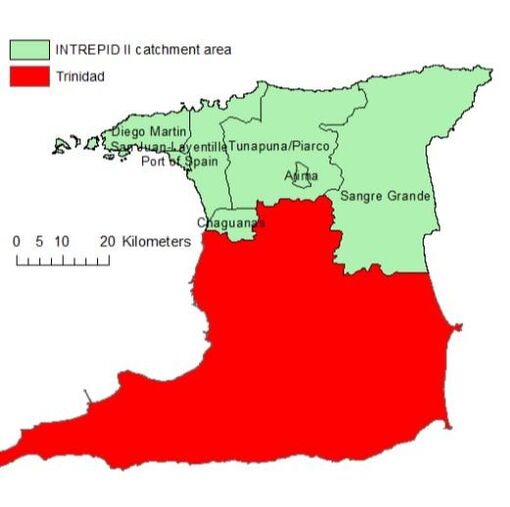The national context: Trinidad and TobagoTrinidad and Tobago is a dual-island country in the south of the Caribbean, with a population of approximately 1.37 million people. Classified by the World Bank as a high-income country, Trinidad and Tobago relies heavily on its energy sector for its economic activity thanks to its large reserves of oil and gas. The age expectancy is 70.67 years and 99% of the population is estimated to be literate. Although English is the country's official language, Trinidadian Creole English and Tobagonian Creole English are most widely spoken.
|
Catchment area for INTREPID II in Trinidad
The catchment area for this study is in Trinidad and consists of the municipalities of Diego Martin, Port of Spain, San Juan/Laventille, Tunapuna/Piarco, Arima, Chaguanas and Sangre Grande. The population at risk is 487,159.
Trinidad and Tobago is a diverse country; because of its colonial history, it is made up of a variety of different ethnicities and religions. The catchment area in Trinidad is made up of approximately 40% African, 30% Indian and 20% mixed race ethnicities with small percentages (<5%) of Caucasian, Syrian/Lebanese and Chinese ethnicities respectively. The major religions represented in the catchment area are Roman Catholic, Hinduism, Islam and Pentecostal.
Population density varies across the catchment area with some municipalities having increased density and urbanicity such as Port of Spain (3,090 persons/sq.km) and other municipalities being more rural such as Sangre Grande (82 persons/sq.km). There are also variations in income per household and crime rates across the catchment area.
Trinidad and Tobago is a diverse country; because of its colonial history, it is made up of a variety of different ethnicities and religions. The catchment area in Trinidad is made up of approximately 40% African, 30% Indian and 20% mixed race ethnicities with small percentages (<5%) of Caucasian, Syrian/Lebanese and Chinese ethnicities respectively. The major religions represented in the catchment area are Roman Catholic, Hinduism, Islam and Pentecostal.
Population density varies across the catchment area with some municipalities having increased density and urbanicity such as Port of Spain (3,090 persons/sq.km) and other municipalities being more rural such as Sangre Grande (82 persons/sq.km). There are also variations in income per household and crime rates across the catchment area.
Hear from the principal investigator of the project in Trinidad...
We asked Professor Gerard Hutchinson, Principal Investigator of INTREPID II (Trinidad), for his thoughts on (a) the most important research question that INTREPID II is investigating, (b) key challenges in doing this type of research in his setting, (c) how the INTREPID I pilot study informed his current work, (d) what services exist for psychosis in this site, and (e) how the INTREPID II evidence can help to improve the lives of people living with psychosis.

